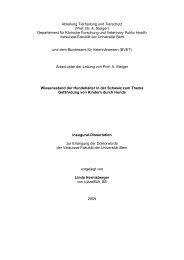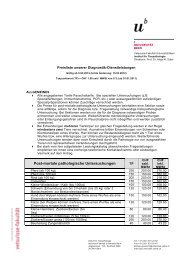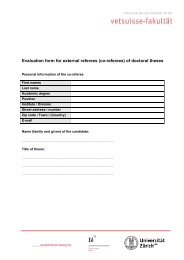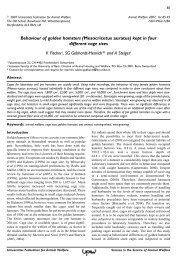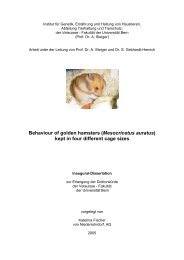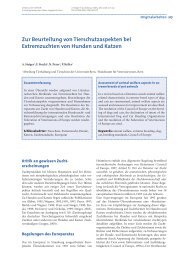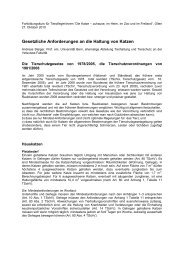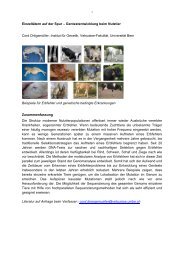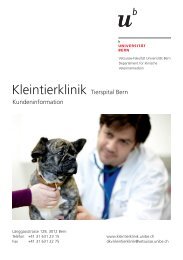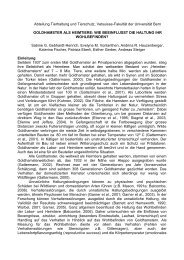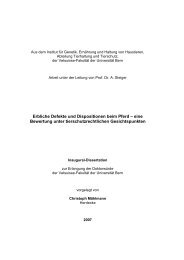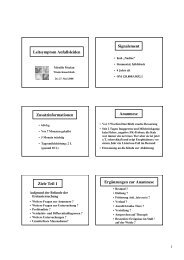Lifespan and Causes of Death in the Irish Wolfhound - Vetsuisse ...
Lifespan and Causes of Death in the Irish Wolfhound - Vetsuisse ...
Lifespan and Causes of Death in the Irish Wolfhound - Vetsuisse ...
You also want an ePaper? Increase the reach of your titles
YUMPU automatically turns print PDFs into web optimized ePapers that Google loves.
3.12.4 Atypical Hepatic Encephalopathy<br />
The occurrence <strong>of</strong> an atypical hepatic encephalopathy as a probable consequence <strong>of</strong><br />
PSS was described <strong>in</strong> two <strong>Irish</strong> <strong>Wolfhound</strong> sibl<strong>in</strong>gs <strong>in</strong> 2003. As opposed to what is<br />
generally seen <strong>in</strong> hepatic encephalopathy, <strong>the</strong> white matter was not predom<strong>in</strong>antly<br />
<strong>in</strong>volved. Histologically, widespread spongiform changes <strong>in</strong> <strong>the</strong> neuropil, fibre<br />
bundles <strong>in</strong>terspersed with<strong>in</strong> <strong>the</strong> grey matter <strong>and</strong> some neuronal vacuoles could be<br />
observed. No <strong>in</strong>fectious agents (rabies or distemper virus, prion prote<strong>in</strong>s) were<br />
detected (Herden, Be<strong>in</strong>eke et al. 2003).<br />
3.12.5 Sp<strong>in</strong>al Nephroblastoma<br />
A sp<strong>in</strong>al nephroblastoma was described <strong>in</strong> a yearl<strong>in</strong>g <strong>Irish</strong> <strong>Wolfhound</strong> male from<br />
South Africa by Vaughan-Scott, Gold<strong>in</strong> et al. (1999), lead<strong>in</strong>g to slowly progressive<br />
paresis <strong>of</strong> <strong>the</strong> left h<strong>in</strong>d limb. This <strong>in</strong>tradural, extramedullary tumour has been<br />
described under various names (e.g. neuroepi<strong>the</strong>lioma, hamartoma, ependymoma,<br />
medulloepi<strong>the</strong>lioma), occurr<strong>in</strong>g <strong>in</strong>frequently between T10 <strong>and</strong> L2 <strong>in</strong> young large<br />
breed dogs. In <strong>the</strong> dog <strong>in</strong> question, it was diagnosed through myelography <strong>and</strong><br />
cerebrosp<strong>in</strong>al fluid analysis, which showed an <strong>in</strong>tradural, extramedullary mass, <strong>and</strong><br />
<strong>the</strong> presence <strong>of</strong> neoplastic cells respectively. Diagnosis was confirmed post mortem<br />
through histopathology.<br />
Given that as opposed to <strong>the</strong> reported case, cl<strong>in</strong>ical symptom onset is usually<br />
described as sudden, this tumour type should be taken <strong>in</strong>to consideration as a<br />
differential diagnosis for FCE (see chapter 3.7.1). Prognosis for complete recovery<br />
after surgical excision is guarded to poor; <strong>the</strong> dog <strong>in</strong> <strong>the</strong> study was euthanised dur<strong>in</strong>g<br />
surgery due to <strong>in</strong>filtrative tumour growth.<br />
3.12.6 Extraocular Myositis <strong>and</strong> Acquired Strabismus<br />
Strabismus follow<strong>in</strong>g conjunctivitis was reported <strong>in</strong> four related <strong>Irish</strong> <strong>Wolfhound</strong>s<br />
(Wolfer 1995). A later study described three cases where strabismus developed as a<br />
result <strong>of</strong> extraocular myositis <strong>and</strong> subsequent fibrosis (Allgoewer, Blair et al. 2000).<br />
The three animals <strong>in</strong> <strong>the</strong> latter study had already been described by Wolfer (1995)<br />
(Wolfer, personal communication) – <strong>the</strong> total number <strong>of</strong> cases <strong>in</strong> <strong>the</strong> literature is thus<br />
four <strong>Irish</strong> <strong>Wolfhound</strong>s<br />
Successful <strong>the</strong>rapy consisted <strong>of</strong> surgical resection <strong>of</strong> <strong>the</strong> <strong>in</strong>flamed/contracted muscle<br />
<strong>in</strong> comb<strong>in</strong>ation with immunosuppression. Given <strong>the</strong> relatedness <strong>of</strong> <strong>the</strong> animals <strong>in</strong><br />
<strong>the</strong>se studies, a hereditary component is possible.<br />
3.12.7 Cervical Spondylomyelopathy (Wobbler Syndrome)<br />
Cervical spondylomyelopathy has been reported to occur <strong>in</strong> <strong>Irish</strong> <strong>Wolfhound</strong>s. The<br />
<strong>in</strong>tervertebral space <strong>of</strong> C3-C4 seems top be most frequently affected <strong>in</strong> <strong>the</strong> breed.<br />
The aetiology <strong>of</strong> <strong>the</strong> condition is uncerta<strong>in</strong>, although genetic predisposition, overnutrition<br />
<strong>and</strong> osteochondrosis (see chapter 3.9) have been suggested to play a role<br />
<strong>in</strong> its development. Signs are most commonly observed before <strong>the</strong> end <strong>of</strong> skeletal<br />
maturation, although <strong>the</strong>y may also become evident at a later age (Ett<strong>in</strong>ger <strong>and</strong><br />
Feldman 1995).<br />
48



